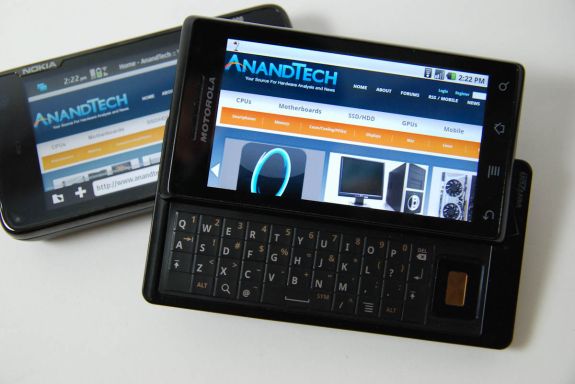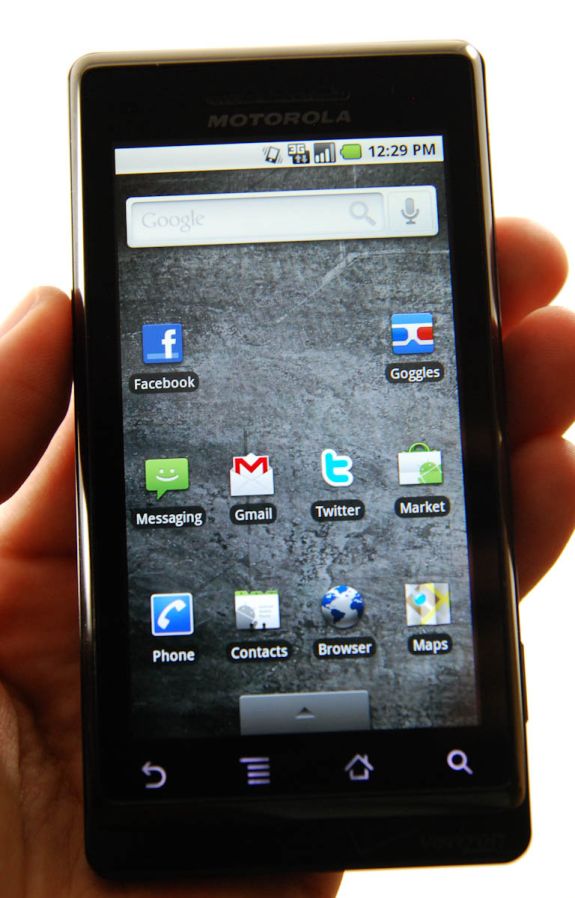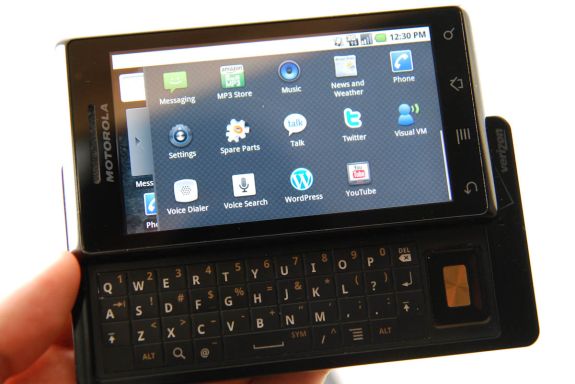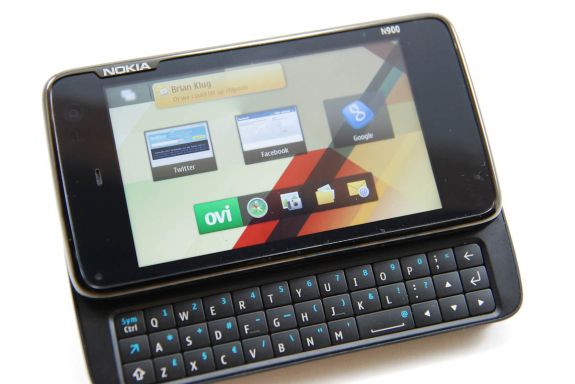Two OMAP 3430 Phones: Nokia N900 and Motorola Droid
by Brian Klug on June 10, 2010 9:29 PM EST- Posted in
- Smartphones
- N900
- Maemo
- Motorola Droid
- Droid
- MeeGo
- Android
- Mobile
The Motorola Droid continues to be the king of Android devices that include a hardware keyboard, and the smartphone which bore the Android flagship crown for some time before the Nexus One. Meanwhile, the Nokia N900 runs Maemo linux 5 - the operating system which - with polish and joint collaboration with intel - will soon emerge as MeeGo and power a host of Moorestown-packing devices. We're doing something a bit irregular by reviewing both phones in one article, but that's again because they're both running on the same Texas Instruments OMAP3 SoC. Let’s dive into both phones and see how they fare.
Motorola Droid - Still Does
As you probably already know, the Motorola Droid marked a turning point for Motorola, for Verizon’s smartphone lineup, and quite possibly a coming of age for Android as the first shipping smartphone with a mature 2.0 release. It wowed the market when it debuted Google Navigation, but puzzled everyone with its initial lack of multitouch support inside all official Google apps - despite packing a full multitouch digitizer.
Since launch, the Moto Droid has and will continue to see continual incremental updates. First, the Android 2.1 update added multitouch to the browser, gallery, and google maps, along with a number of other improvements brought alongside the entire platform update. At Google I/O 2010, we’ve now learned that the Moto Droid will see another update to Android 2.2 before year’s end - bringing a promised 2-5x speed boost to Android’s Dalvik virtual machine with a new JIT compiler, full in-browser Flash 10.1 in addition to Adobe Air support, cloud-to-device push APIs, OS-level WiFi tethering, and browser speed increases among other features.
It’s obvious that despite the recent release of the HTC Incredible, the Moto Droid will continue to hold a place in Verizon’s growing lineup of Android smartphones - and likely at a lower price point than HTC’s new flagship. Currently, Verizon is offering a buy one get one free Motorola Droid promption with purchase and a 2-year contract.
The Droid’s chief differentiating factor (other than likely continued lower price point) is the hardware keyboard. For so many, having a hardware keyboard is still a fundamentally important feature, though virtual keyboards aren’t as bad as they used to be - and they’re getting better. As an aside, it’s amazing how quickly ‘Big Red’ Verizon turned its lineup around and became host to so much Android hardware.
Nokia N900 - a ‘mobile computer’
There’s no doubt about it - the Nokia N900 is a unique beast. In fact, it’s that uniqueness which makes it a difficult sell for all but the most hardcore smartphone consumers, but also potentially the most powerful. The N900 is a landscape QWERTY slider with a 3.5” resistive LCD, front and back facing cameras, 3G HSPA for T-Mobile bands, and runs the debian derivative Maemo 5 OS.
I think it’s a fair argument to make that the N900 hasn’t received as much love state-side as it has abroad, or rightfully deserves. That’s probably due in part to only being sold unlocked with no subsidy, by no specific carrier (though it is targeted at T-Mobile for 3G support, and will work with 2.5G EDGE on AT&T), for $499 at retailers like Amazon. But it isn’t just Nokia grappling with that issue - Google recently learned how hard of a sell unsubsidized, bring your own plan schemes are with its Nexus One. In general, it’s hard to sell people on a $500+ smartphone if they can’t try the device beforehand, or get carrier support.
That aside, the N900 is likely the final evolution in a long chain of internet tablets designed by Nokia - starting with the N770 in 2005. Maemo linux has been as open as open source can be since the very beginning; its application manager started as little more than an APT frontend. If you prefer, it can even still be used that way from the XTerm terminal with an apt-get install. It’s a platform that’s been adorned and worshiped as the ultimate linux smartphone platform by hardcore *nix nerds ever since, and I intend to do it justice.














68 Comments
View All Comments
DaveGirard - Saturday, June 12, 2010 - link
sweet Jesus, that Nokia phone is huge. Does it double as an ice cream sandwich cover?metafor - Sunday, June 13, 2010 - link
Cortex is the CPU designed by ARM. This is available as a hard-macro (layout already done) or soft-macro (just the functional RTL). Some companies license this in either version. For those who license the soft-version, such as TI, nVidia and Broadcom, they can do a customized place-and-route along with clock-tree optimizations and voltage partitioning to try to make the design run faster.However, the micro-architecture is the same.
A few companies have ARM architectural licenses (Apple, Qualcomm, Marvell) and instead of licensing the Cortex line of processors, they design their own. The micro-architecture is developed independent of what ARM did in their Cortex series albeit there will often be similarities.
Scorpion inside Snapdragon was developed in the course of years and while it has many similarities to the A8 from a power-point standpoint, the micro-architecture underneath was designed from the ground up. Everything from the branch predictors, the cache controller, exception handling, execution units and most notably, a partially OoOE scheduler and retirement buffer.
There's also the 128-bit, fully pipelined, partially OoOE SIMD/FP unit.
medi01 - Sunday, June 13, 2010 - link
Well, I find it very strange, that "incidentally" iPhone is never shown in bad light. Could you please update your side to side comparison?Impulses - Wednesday, June 16, 2010 - link
Personally I think there's better things for you guys to do or test with your time... Who cares if a phone's screen colors are more or less accurate, as long as they aren't outright flawed or ugly to look at it shouldn't be a big deal, not like anyone's gonna be doing any pro content editing work on their phones! (I don't even own an AMOLED screen so I'm not particularly biased one way or the other, I own an EVO atm)mojtabaalemi - Saturday, June 19, 2010 - link
I hate the design of nokia mobile phones . in my idea an iphone is far far better !paihuaizhe - Sunday, June 20, 2010 - link
(nike-alliance).(com)=>is a leading worldwide wholesaler company (or u can sayorganization)
arnavvdesai - Saturday, June 26, 2010 - link
I was just wondering if the author had installed AdBlock+ and then run the browser speed numbers or without it being on. If it was not installed which is what I am guessing from the photos, did you notice an improvement in the render times when it was installed. I actually bought the phone recently after seeing it on sale for 380$ and wanted to know the details. Also, I have heard that the current build of the OS allows potrait mode even for the browser(although it has to be activate through some setting) and not just the phone.drwiremore - Sunday, July 4, 2010 - link
Amanda, delighted to have found you. Given the issues in the title, affecting 20~50% of MOTO Droid users, was surprised to see no mention of it. The MOTO boards are alive with disdain and some feel an in you face attitude by Motorola Droid 2 and X announcements. Would you do an iPhone like analysis of voice, antenna and signal issues across Verizons Droids: HTC incredible and MOTO Droid. Your scientific analysis would be welcomed.